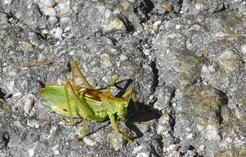New mechanistic insights into adaptive learning
The brain is a fantastically complex and mysterious device, too large and with too many internal connections to be entirely programmable genetically. Its internal connectivity must therefore self-organize, based on the one hand on genetically regulated biases and on experience and learning on the other. The brain can change its internal connectivity based, for example, on correlations between the inputs it receives and the consequences of actions associated with those inputs, in a phenomenon we generally call associative learning. There are, in our daily life, numerous examples of this type of learning; its consequence is that a smell or a tune on the radio can trigger memories from the past, which lay dormant for some time. "Such a recall - to a smell, sound, taste, or any other sensory stimulus - is evidence of associative learning, and what interested us here was to understand the tricks used by the brain to make these associations specific", says Gilles Laurent, Director at the Max Planck Institute for Brain Research.

Laurent and Cassenaer used grasshoppers to study associative learning. (© MPG)
Together with his former Caltech student and postdoctoral fellow Stijn Cassenaer, Gilles Laurent set out to examine the phenomenon using insects as model system. A structure of great importance for learning in the insect brain is called the mushroom body. It is composed of a great many neurons (several hundreds of thousands in honeybees for example), and has been shown to be indispensable for several forms of olfactory learning (that is, learning associated to smells). What Cassenaer and Laurent set out to do was to explain an apparent paradox: how can a given odour be specifically memorised following an association with a reward, knowing that the brain signals representing reward are broadcast broadly into the mushroom body and therefore, not specific on their own.
They found that the answer relies on an interaction between the reward signal and a synaptic phenomenon known as spike-timing-dependent plasticity (STDP), itself discovered some 15 years ago by Henry Markram and Bert Sakmann, then at the Max Planck Institute for Medical Research in Heidelberg. The new results indicate that STDP on its own - the strengthening or weakening of synaptic connections between neurons, that depends on the firing of those neurons in quick succession of one another - serves as a "tag" for the synapses that need modifying. Once so identified, the nonspecific reward signal can act specifically, and does so only at those precisely marked synapses. Laurent: "The discovery of this modulation is just the beginning. The molecular underpinning as well the process associated with the read out of the memories, are areas of much need-exploration".
The study, "Conditional modulation of spike-timing-dependent plasticity for olfactory learning," was funded by the Lawrence Hanson Chair at Caltech, the National Institutes on Deafness and other Communication Disorders, Caltech's Broad Fellows Program, the US Office of Naval Research, and the Max Planck Society.












